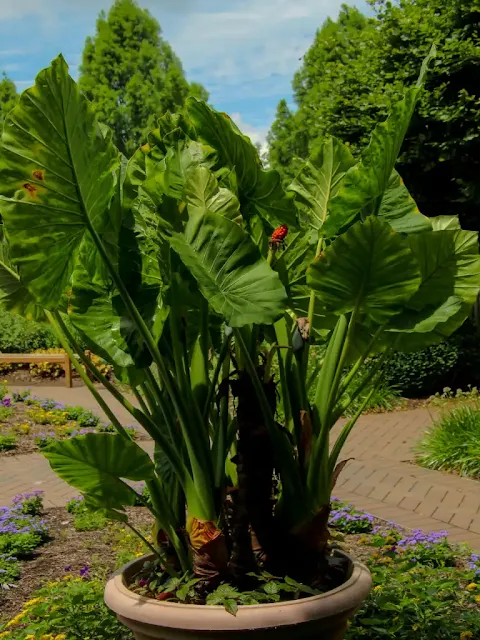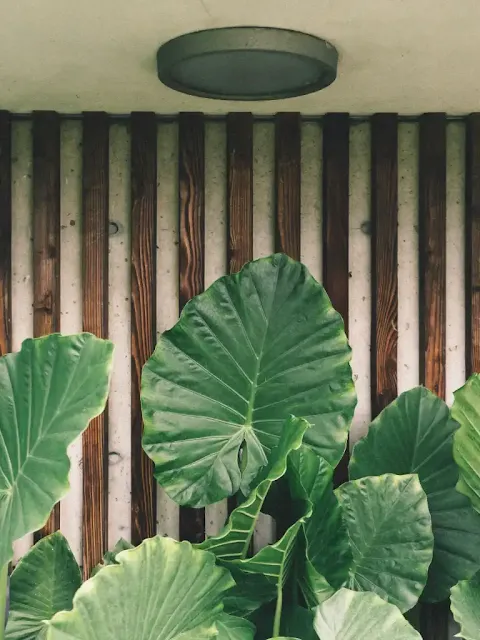The elephant ear plant is a stunning tropical beauty known for its enormous, heart-shaped leaves that resemble—you guessed it—elephant ears. With its bold foliage and lush appearance, this plant instantly adds a dramatic flair to gardens, patios, and indoor spaces alike.
Elephant ears belong to several plant genera, most commonly Alocasia, Colocasia, and Xanthosoma. While each variety has its own unique traits, they all share a love for warmth, moisture, and rich soil. Some species, like Colocasia, prefer wetter conditions and are often grown in water gardens, whereas Alocasia typically thrives in slightly drier, well-draining soil.
Whether you're growing them indoors as houseplants or outdoors in your garden, elephant ear plants can be a striking focal point—if you know how to care for them properly. In this guide, we’ll walk you through how to grow, care for, and maintain a healthy elephant ear plant year-round.
Elephant Ear Plant Overview
- Name: Elephant Ear Plant
- Family: Araceae
- Mature Size: Typically 3 to 6 feet tall and wide (varies by species)
- Plant Type: Perennial herbaceous plant (often grown as annuals in colder climates)
- Botanical Name: Common species include Colocasia esculenta, Alocasia spp., and Xanthosoma spp.
- Sun Exposure: Partial shade to full sun (depends on species, many prefer partial shade)
- Soil Type: Moist, well-drained, rich soil; thrives in loamy or sandy soil with good organic matter
- Bloom Time: Summer to early fall (though flowers are often inconspicuous)
- Flower Color: Usually greenish or pale, rarely showy
- Hardiness Zones: USDA zones 8-11 (tender in colder zones; often grown as annuals or indoors in cooler areas)
- Native Area: Tropical and subtropical regions of Asia, South America, and the Pacific Islands
- Toxicity: Yes, contains calcium oxalate crystals; toxic if ingested by humans and pets, can cause irritation
Topics Related To Garden:
How to Grow Elephant Ear Plant
Elephant ear plants are relatively easy to grow, whether you're placing them in your garden or bringing tropical flair indoors. Here’s what you need to know to get started.
Choosing the Right Variety
The first step to successfully growing an elephant ear plant is choosing the right variety for your space and climate. The three most common genera are:
- Alocasia: Known for upright, arrow-shaped leaves with prominent veins. These are ideal for indoor environments or shaded outdoor areas.
- Colocasia: Typically features downward-facing leaves and thrives in wet or boggy soil. Perfect for outdoor gardens, especially near water features.
- Xanthosoma: Less common but equally striking, with large, sagittate leaves. Best suited for warm, humid climates.
Each has different light and moisture requirements, so consider where you plan to grow them before selecting your plant.
Ideal Growing Conditions
To grow elephant ear plant flower successfully, you need to mimic their native tropical habitat as much as possible.
- Soil: Choose rich, organic, well-drained soil. Colocasia varieties tolerate wetter conditions, but all types benefit from nutrient-dense compost or organic matter.
- Sunlight: Most elephant ears plant prefer partial shade, though some varieties (especially Colocasia) can handle full sun if provided with enough water.
- USDA Hardiness Zones: These plants thrive in zones 8–11. In cooler climates, they’re best grown as annuals or overwintered indoors.
Planting the Bulbs
Elephant ear plants grow from bulbs, tubers, or rhizomes, which should be planted in the spring once the soil has warmed to at least 65°F (18°C).
- When to Plant: After the last frost date in your area.
- How to Plant: Place the bulb about 2–4 inches deep, with the pointed end facing up. Water well after planting.
- Spacing: Space each bulb 2 to 4 feet apart, depending on the mature size of the variety.
- Containers vs. Ground: In containers, use a large pot with drainage holes and rich potting mix. Ground planting allows more room for growth but may require lifting the bulbs before winter in colder zones.
Topics Related To Garden:
How to Care for Elephant Ear Plant
elephant ear plant care: Proper care is key to keeping your elephant ear plant healthy and vibrant. From watering routines to ideal lighting, here’s how to give your tropical foliage the care it craves.
Watering Needs
Elephant ears are water-loving plants, but there’s a fine balance between keeping them moist and drowning their roots.
How Often to Water:
Water frequently, especially during the growing season (spring and summer). Outdoor plants may need watering every 1–2 days in hot weather, while indoor plants typically require watering once or twice a week.
Moisture vs Drainage:
The soil should remain consistently moist, not soggy. Ensure good drainage, especially for Alocasia varieties, which are more sensitive to waterlogged soil.
Signs of Overwatering or Underwatering:
- Overwatering: Yellowing leaves, root rot, and mushy bulbs.
- Underwatering: Drooping, dry leaf edges, and stunted growth.
Feeding and Fertilization
Because of their rapid growth and large foliage, elephant ear plants are heavy feeders.
Recommended Fertilizers:
Use a balanced fertilizer such as 10-10-10 or one slightly higher in nitrogen (like 20-10-10) to support leaf growth.
Frequency and Method:
Feed every 2–4 weeks during the growing season. Use liquid fertilizer for quick absorption or slow-release granules for steady nourishment.
Organic vs Chemical Options:
Organic options like compost tea, fish emulsion, or worm castings are gentle and enrich soil health. Chemical fertilizers offer fast results but require careful use to avoid root burn.
Lighting and Temperature
Elephant ears are true tropicals, so warmth and the right lighting are crucial.
Best Light Conditions:
- Alocasia: Bright, indirect light or filtered sunlight.
- Colocasia: Can tolerate more direct sun, especially outdoors.
Indoor Lighting Tips:
Place near east- or west-facing windows. If natural light is low, supplement with grow lights.
Temperature & Humidity:
Ideal range is 65–85°F (18–29°C). These plants also thrive in high humidity, so consider misting regularly or using a humidifier indoors.
How to Maintain a Healthy Elephant Ear Plant
Even with the best care, elephant ear plants can face challenges. Keeping them healthy requires regular attention to pests, pruning, and seasonal changes—especially in colder climates.
Common Pests and Diseases
Elephant ears are generally hardy, but they can fall prey to several common pests and fungal issues:
Pests:
- Spider mites: Look for tiny webs under leaves and yellow speckling.
- Aphids: Small green or black insects clustering on stems or new growth.
Diseases:
- Fungal root rot: Caused by overwatering or poor drainage. Symptoms include wilting, yellowing, and mushy roots.
Treatment Tips:
- Natural options: Neem oil, insecticidal soap, or a strong stream of water can manage mild infestations.
- Chemical solutions: Use systemic insecticides or fungicides as a last resort and follow label directions carefully.
- Preventive care: Good airflow, clean tools, and avoiding overhead watering help minimize disease risks.
Pruning and Leaf Care
Healthy leaves mean a healthy plant.
- Remove Damaged Leaves: Trim any yellow, wilted, or torn leaves using clean, sharp scissors or shears.
- Routine Cleaning: Wipe down the massive leaves with a damp cloth to remove dust, especially for indoor plants. This helps the plant “breathe” and prevents pest buildup.
Overwintering Tips
If you live in a region where temperatures drop below 50°F (10°C), you'll need to take extra steps to preserve your plant through the winter.
For Outdoor Plants in Cold Zones:
- Dig up the bulbs after the first frost.
- Clean them and allow them to dry for a few days.
- Store in a cool, dark place in dry peat moss or sawdust until spring.
Indoor Transition:
- Before frost hits, bring container plants inside.
- Reduce watering and stop fertilizing to allow the plant to go dormant.
- Place in a cool room with indirect light.
Outdoor Insulation:
- In slightly warmer zones (Zone 7 and above), apply a thick layer of mulch to insulate bulbs left in the ground.




